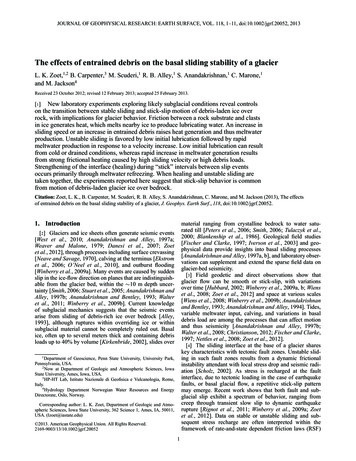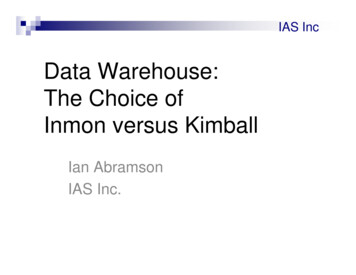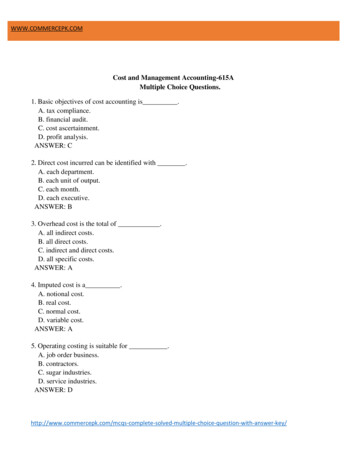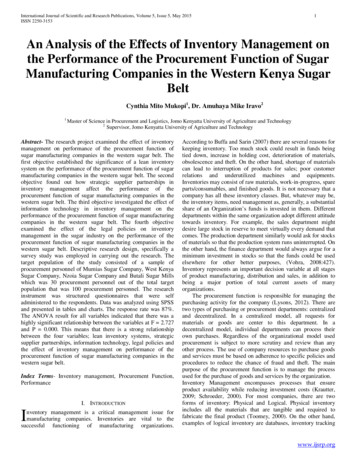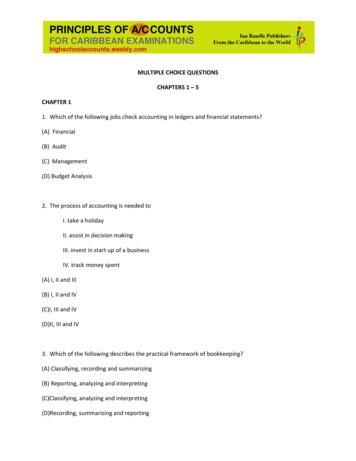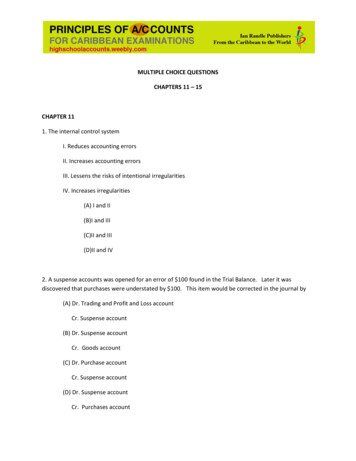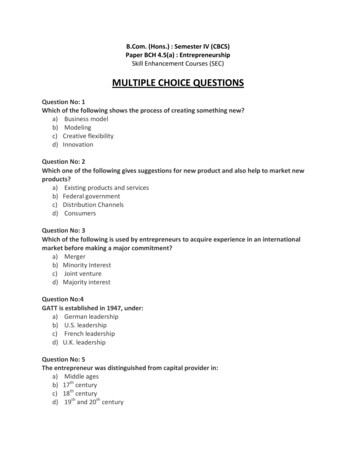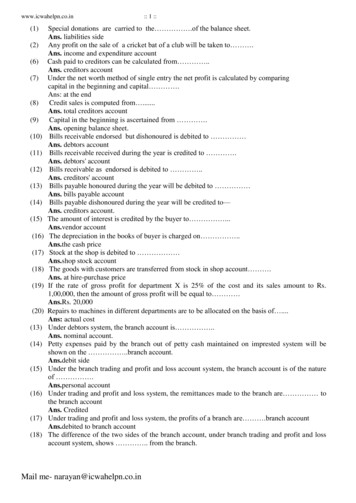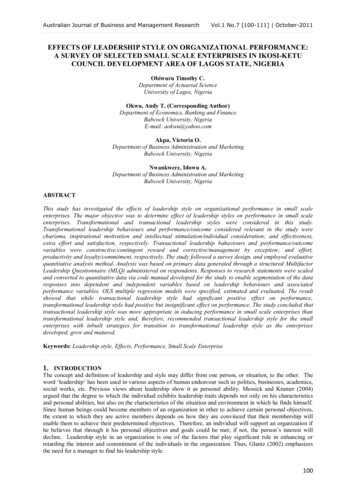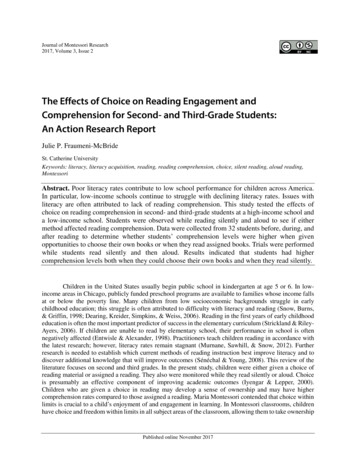
Transcription
Journal of Montessori Research2017, Volume 3, Issue 2The Effects of Choice on Reading Engagement andComprehension for Second- and Third-Grade Students:An Action Research ReportJulie P. Fraumeni-McBrideSt. Catherine UniversityKeywords: literacy, literacy acquisition, reading, reading comprehension, choice, silent reading, aloud reading,MontessoriAbstract. Poor literacy rates contribute to low school performance for children across America.In particular, low-income schools continue to struggle with declining literacy rates. Issues withliteracy are often attributed to lack of reading comprehension. This study tested the effects ofchoice on reading comprehension in second- and third-grade students at a high-income school anda low-income school. Students were observed while reading silently and aloud to see if eithermethod affected reading comprehension. Data were collected from 32 students before, during, andafter reading to determine whether students’ comprehension levels were higher when givenopportunities to choose their own books or when they read assigned books. Trials were performedwhile students read silently and then aloud. Results indicated that students had highercomprehension levels both when they could choose their own books and when they read silently.Children in the United States usually begin public school in kindergarten at age 5 or 6. In lowincome areas in Chicago, publicly funded preschool programs are available to families whose income fallsat or below the poverty line. Many children from low socioeconomic backgrounds struggle in earlychildhood education; this struggle is often attributed to difficulty with literacy and reading (Snow, Burns,& Griffin, 1998; Dearing, Kreider, Simpkins, & Weiss, 2006). Reading in the first years of early childhoodeducation is often the most important predictor of success in the elementary curriculum (Strickland & RileyAyers, 2006). If children are unable to read by elementary school, their performance in school is oftennegatively affected (Entwisle & Alexander, 1998). Practitioners teach children reading in accordance withthe latest research; however, literacy rates remain stagnant (Murnane, Sawhill, & Snow, 2012). Furtherresearch is needed to establish which current methods of reading instruction best improve literacy and todiscover additional knowledge that will improve outcomes (Sénéchal & Young, 2008). This review of theliterature focuses on second and third grades. In the present study, children were either given a choice ofreading material or assigned a reading. They also were monitored while they read silently or aloud. Choiceis presumably an effective component of improving academic outcomes (Iyengar & Lepper, 2000).Children who are given a choice in reading may develop a sense of ownership and may have highercomprehension rates compared to those assigned a reading. Maria Montessori contended that choice withinlimits is crucial to a child’s enjoyment of and engagement in learning. In Montessori classrooms, childrenhave choice and freedom within limits in all subject areas of the classroom, allowing them to take ownershipPublished online November 2017
JoMR Fall 2017Volume 3 (2)THE EFFECTS OF CHOICE ON READING ENGAGEMENTFraumeni-McBrideand initiative in their learning (Lillard, 2005). The Montessori education system implements choice as anessential component of children’s learning. The current study implies that the Montessori component ofchoice may also be effective in a non-Montessori setting.BackgroundPoor literacy rates are attributed to various factors such as income level, one of several factors thatcannot adequately be addressed by a school’s curriculum (Barnett, 1995). The mechanisms that enable achild to read successfully best indicate where a curriculum should focus. Research presents an array ofvaluable insights dissecting the important components of reading instruction so that children are able toprogress toward literacy. Barriers to literacy were outlined by Stanovich (1986). In his seminal review ofthe literature, he stated that children who read more slowly and with little enjoyment tend to read lessfrequently than those who read more fluidly and with more enjoyment, resulting in delayed vocabularydevelopment and stunting their ability to read. According to Gardiner (2005), reading is a skill that studentsmust come to enjoy; otherwise, it can impede their overall education. Children’s enjoyment of readingaffects their reading success through all grade levels and into adulthood. For this reason, it is important tofocus on how schools can improve children’s reading enjoyment levels in elementary school. This focuscould improve literacy acquisition, and more specifically, reading comprehension. This research assessedthe effect of choice on children’s reading comprehension and enjoyment. In a review of the literature, theauthor examined studies related to choice, silent reading versus reading aloud, and measurements of readingcomprehension.Choice and SatisfactionSeveral notable studies discuss choice and satisfaction. Iyengar and Lepper (2000) revealed thatpeople are more likely to make a choice when offered six or fewer choices, rather than 24 or 30. Participantswere given a choice of topics for a college essay. One group was given a large number of choices (i.e., 30),while another group was offered a small number of choices (i.e., six). Participants reported greatersatisfaction with their selections when their original set of options had been limited. Although this studywas conducted using college students, similar results may be found among other age groups. This researchsupports the idea that a reasonable number of choices improves the likelihood that participants associateenjoyment with their decisions. Choice creates a feeling of ownership; however, limits need to beconsidered when administering choice for optimal outcomes (Iyengar & Lepper, 2000).According to Campbell and Donahue (1997), teachers reported student interest and choice to befactors in test performance. Eighth and twelfth graders who were given a choice in reading more positivelyperceived those readings. Despite these positive perceptions, statistically significant results were not seenwhen twelfth-grade students were given a reading comprehension test for the choice reading, while slightlystatistically significant negative results were seen among eighth graders. Although these results showedthat students did not score better on reading assessments when given the opportunity to choose their books,the findings did show that student perceptions of the assignments were more positive.A study by Reibstein, Youngblood, and Fromkin (1975) suggested similar results to those found byIyengar and Lepper (2000). Those who had been given a greater selection expressed higher levels ofsatisfaction with their choices compared to those with no choice. The study suggests that choice increasesperceived freedom, thereby increasing satisfaction with one’s choice. Choice is an important factor inindividual satisfaction. Student choice in learning enhances determination, ownership, motivation, andinvolvement (Vitto, 2003).Lewis, Alessandri, and Sullivan (1990) studied infants aged 2 to 8 months. While monitored, infantsmoved their arms to control stimuli and then underwent randomized stimuli. Study results revealed thatinfants who had control over stimuli were more interested in their environments. Similarly, Deci, Schwartz,20
JoMR Fall 2017Volume 3 (2)THE EFFECTS OF CHOICE ON READING ENGAGEMENTFraumeni-McBrideSheinman, and Ryan (1981) included observation reports from teachers of fourth- through sixth-gradestudents. Teachers reported that when students had more autonomy, they were more intrinsically motivatedto learn and displayed higher levels of independence and confidence. Students’ perceived level of controlimproved their academic performance.Reading Silently Versus AloudStudies have shown that favorable results exist in both silent and aloud reading. Wiesendanger andBirlem (1984) revealed that, in nine of 11 research studies of elementary-aged children, students’ positiveattitude toward reading increased in schools whose curriculum included Sustained Silent Reading (SSR).Takeuchi, Ikeda, and Mizumoto (2012) used imaging techniques to monitor brain activity while subjectsread aloud. Results showed that brain activity increased, suggesting a cognitive explanation for theeffectiveness of reading aloud. Chow and Chou (2000) found that providing choice in combination withSSR resulted in increased reading comprehension outcomes.According to Krashen (as cited in Sanden, 2014), silent reading improves the skills needed forcomprehension. The study showed that elementary-aged students in SSR programs performed as well as orbetter in reading comprehension measures than did students in traditional reading comprehension programs.Because the results did not display statistically significant outcomes, more research is needed to determineif the increased comprehension was caused by the SSR program. The National Reading Panel (Hasbrouck,2006) stated that there is not enough empirical research to support the idea that silent reading results inincreased reading comprehension.The outcomes of studies of both SSR and reading aloud are conflicting or neutral (Hawkins, Hale,Sheeley, & Ling, 2011; McCallum, Sharp, Bell, & George, 2004). Because it is not clear which type ofreading has a more positive effect on children’s reading comprehension, both variables need further study.Measures of ComprehensionReading is an important part of early childhood curriculum and education. The purpose of readingis to create meaning, while the overall goal of literacy is comprehension. According to Burns, Griffin, andSnow (1999), comprehension refers to the understanding of spoken and written language. Languagecomprehension skills are the foundation of reading comprehension. As early as kindergarten, teachersmonitor students’ oral language comprehension skills (Storch & Whitehurst, 2002). It is important to checkcomprehension both during and after reading to determine if children are developing these skills (Olofsson& Niedersøe, 1999). Two broad classes of skills are important for later reading performance: code-relatedskills and oral language skills (Storch & Whitehurst, 2002; NICHD Early Child Care Research Network[NICHD Early Child Care], 2005; Whitehurst & Lonigan, 1998). Because preschool children are beginningto learn these skills, it is important for instructors to focus on teaching oral language and comprehension atthe beginning stages of reading to supply students with the fundamental skills necessary to achieveappropriate and expected comprehension levels. Oral language skills include “receptive and expressivevocabulary, syntactic and semantic knowledge, and narrative discourse processes such as memory,comprehension and storytelling” (NICHD Early Child Care, 2005, p. 428). The critical skills of orallanguage are vocabulary and comprehension; for students to develop strong oral language skills, they needto develop proficient comprehension. According to Epstein (2007), as oral language improves, so doesreading comprehension. Hohmann (2005) stated, “Comprehension is the process of deriving meaning fromaction, speech, and text by connecting what you are learning to what you already know . Children makemeaning by assimilating new information into previous understanding” (p. 2). Burns et al. (1999) claimedthat comprehension during the preschool years allows children to better understand spoken language andwhat is read to them; comprehension begins in their everyday conversations as they show understanding ofspeech through engagement and conversation with their parents, teachers, and peers. To gauge21
JoMR Fall 2017Volume 3 (2)THE EFFECTS OF CHOICE ON READING ENGAGEMENTFraumeni-McBridecomprehension, teachers need to know how to measure it. Comprehension can be measured by monitoringchildren’s reactions to reading materials. As children ask questions and make comments while they read,they should be able to relate information from the book to their own experiences, evidenced in commentsmade during reading or in responses to the reading (Burns et al., 1999).MethodologyThis study was conducted at two schools in Chicago: a low-income school and a high-incomeschool. The low-income school’s public report showed that 97.4% of its students came from families thatlived below the national poverty level. The high-income school included participants from a private schoolin which most of the families were categorized in the middle to upper socioeconomic class. While the highincome school’s public report does not provide specific information about the incomes of its families,individual tuition costs between 15,000 and 23,000 per year, with limited scholarship availability,making this school available exclusively to students from higher-income households. Thirty-two studentsparticipated over a period of 6 weeks. In each school, teachers randomly selected 8- and 9-year-old studentsfor participation: 10 boys and 11 girls from the high-income school and four boys and seven girls from thelow-income school. Because many students did not have reliable transportation to school, their attendancewas unpredictable. To maintain consistency in the evaluation process, only those with consistenttransportation to school were allowed to participate.The literature review outlined findings that support the major components of this research study.Choice was identified as an important variable that may predict students’ enjoyment and increase theirreading comprehension (Iyengar & Lepper, 2000). The researcher of the current study concluded thatmonitoring children while reading silently and then aloud would help to analyze the impact that readingsilently versus aloud has on reading enjoyment (National Institute of Child Health and HumanDevelopment, 2000). The current study used four measures to gauge reading comprehension: (a) selfassessment (see Appendix A), (b) researcher observation sheet for questions and comments made by eachchild throughout reading (see Appendix B), (c) researcher observation scale for recording children’s interestduring reading (see Appendix C), and (d) reading quiz administered upon completion of the reading (seeAppendix D). The four comprehension measures were derived from the previously discussed research tomore accurately assess student comprehension of the reading (Burns et al., 1999). Since enjoyment wasprojected to be the root cause of higher comprehension levels, the variable that instigated this change waschoice, which is associated with greater enjoyment and satisfaction (Iyengar & Lepper, 2000; Reibstein etal., 1975). To eliminate bias, different sample groups read aloud and silently. It was predicted that readingchoice would increase reading enjoyment, thereby increasing comprehension. Research suggests thatchoice is an important factor in reading comprehension, but more information is needed. The current studyattempted to discover whether choice positively affects comprehension in second- and third-grade childrenin high- and low-income schools.Participants were individually assessed in a quiet room outside of the classroom over the 6-weekperiod. Students were first assigned a grade-appropriate (i.e., second or third grade) reading from theReading A–Z series, and then were given four evaluations (see Appendices A–D) to measurecomprehension. After completing the assigned reading and evaluations, students chose one of three booksto read (also from the Reading A–Z series). The same evaluations were conducted after choice reading. Forthe first three trials, students read both the assigned and chosen readings aloud; in the last three trials of thestudy, children read assigned and chosen readings silently. Each child participated in one segment ofassigned and choice readings per trial. The children completed 12 readings over the course of the study, sixassigned and six chosen. In each trial, students first read the assigned reading, followed by evaluation anda quiz measuring comprehension (see Appendices A–D). After completing the assigned segment, studentscompleted the choice segment, in which they were presented with three reading options, followed byevaluation and a quiz measuring comprehension (see Appendices A–D). At the end of each segment,22
JoMR Fall 2017Volume 3 (2)THE EFFECTS OF CHOICE ON READING ENGAGEMENTFraumeni-McBridestudents were asked which reading they preferred, assigned or chosen. Because all participants read theassigned reading first, it is possible that maturity explained the improvement seen in reading comprehensionor reading preference.For the assigned readings, children were given books and instructed to read them silently or aloud.They were told they could ask questions or make comments before, during, and after reading. As they read,the researcher used a 10-point scale to evaluate their perceived levels of interest, focus, enjoyment, andcomprehension, with 1 being the lowest level and 10 being the highest level (see Appendix C). To gaugestudents’ interest, the researcher observed and coded their facial expressions (e.g., smiling, gasping, or anychange in expression). To measure focus, the researcher observed and coded students’ reading intensity(e.g., appearance of distraction, looking away from the book, pausing randomly, sluggishness, slouching,or appearance of engagement). To measure enjoyment, the researcher observed and coded students’ positivefacial expressions while reading. Enjoyment overlapped somewhat with interest, although enjoymentfocused on students’ overall appearance of relaxation and ease in reading. To measure students’ perceivedcomprehension, the researcher observed and coded gestures, intensity of focus, and appearance ofengagement (i.e., Did the reader express enjoyment, focus, and interest?) Participant questions andcomments from before, during, and after the readings were recorded on an observation sheet (see AppendixB).Researcher observations were used to compare researcher perception of child’s comprehensionlevels to actual quiz results that gauged reading comprehension. Researcher observations of perceivedfocus, enjoyment, interest, and engagement were not definitive measures yet provided insight about signschildren may display during reading that can be compared to actual test results. After completing thereading, participants were given a reading comprehension quiz; these quizzes were created by the ReadingA–Z series for each reading (see Appendix D). After students took the quiz, they read several statementsand were asked to use a 5-point scale to describe how often the statements were true for them, with 1meaning not at all and 5 meaning all the time (see Appendix A). Afterward, they were asked to choose fromamong three books, and the same process of evaluating comprehension was repeated. As part of the datacollection, after completing the assigned and chosen readings and the assessment, children were askedwhich reading they preferred. Each child completed this process once per week over a period of 6 weeks(i.e., each child completed one cycle each of assigned and choice trials per week). The following bookswere used for the readings: Trial 1: Healthy Me; Math Test Mix-Up; Winter Vacation; Monsters on Wheels Trial 2: Thank You, Everyone!; Caretakers; Carlos and His Teacher; The Mitten Trial 3: I’d Like to Be; At the Library; What Has This Tail?; Winter Fun Trial 4: I Need an Eraser; Josh Gets Glasses; Stone Soup; A Cold Day Trial 5: The Magic Bike; Darby’s Birthday Party; Firefighters; Extreme Insects Trial 6: Bats Day and Night; Hugs to Daddy; Spring Is Here; Goats Are Great23
JoMR Fall 2017Volume 3 (2)THE EFFECTS OF CHOICE ON READING ENGAGEMENTFraumeni-McBrideAnalysis of DataThe data were collected using test scores, researcher observations, self-assessme
Published online November 2017 . The Effects of Choice on Reading Engagement and Comprehension for Second- and Third-Grade Students: An Action Research Report . Julie P. Fraumeni-McBride . St. Catherine University . Keywords: literacy, literacy acquisition, reading, reading comprehension, choic
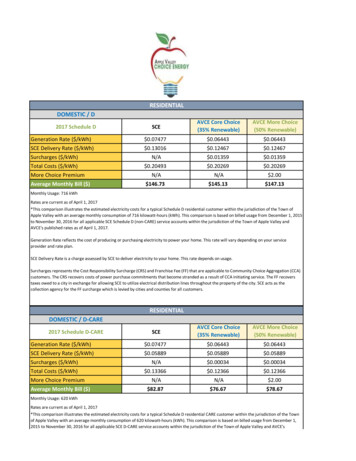

![[digital] Visual Effects and Compositing](/img/1/9780321984388.jpg)
